Numerical Investigation on Effects of Assigned EGR Stratification on a Heavy Duty Diesel Engine with Two-Stage Fuel Injection
Abstract
:1. Introduction
2. Materials and Methods
2.1. Numerical Approach
- (a)
- Bai’s spray impingement model was employed to distinguish wall impingement by Lagrangian approach, on the basis of literature findings and mass, momentum and energy conservation constraints. The model formulation distinguished between dry and wetted wall impingement and the STAR-CD implementation also makes this distinction. Incidence angle, incident droplet velocity relative to the wall and droplet size and properties and so on governed a variety of impingement regimes. When Tw ≤ Ts, the regimes of stick, rebound, splash and break-up are recognized at dry wall conditions (only when the liquid film model is in use). Adhesion (combines the stick and spread regimes):Wed ≤ WeaWea = A L−0.18where A is a coefficient which depends on the surface roughness.La = ρdσdDd/μd2
- (b)
- Splash:Wed > Wea
2.2. EGR Composition
3. Validation of Simulation Model
4. Results and Discussion
4.1. Comparisons between Uniform EGR and Assigned EGR Stratification
4.2. Effects of Interval of Main and Post Injection on Assigned EGR Stratification Combustion
4.3. Effects of the Start of Main Injection of Two-Stage Fuel Injection on Assigned EGR Stratification Combustion
5. Conclusions
- (1)
- Both specific engine-out NOx and soot emissions of assigned EGR stratification are lower than that of uniform EGR, with little penalty on cylinder pressure and heat release rate under the case that EGR mass in cylinder between uniform EGR and assigned EGR stratification is equal.
- (2)
- Both NOx and soot emissions decreased when the interval between main and post fuel injection decreased from 7 to 4 °CA, under which conditions work per cycle transferred to the piston is higher. The case with 4 °CA interval between main and post fuel injection is suitable for an acceptable efficiency-emissions trade-off.
- (3)
- The trade-off between NOx and soot still exists under the case of EGR stratification with different main fuel injection timing. A deterioration of soot emissions was observed when the start of the main fuel injection is delayed, while NOx emissions reduced. The case with −10 °CA ATDC start of main fuel injection is suitable for acceptable NOx and soot emissions.
Acknowledgments
Author Contributions
Conflicts of Interest
References
- Mansor, M.R.A.; Abbood, M.M.; Mohamad, T.I. The influence of varying hydrogen-methane-diesel mixture ratio on the combustion characteristics and emissions of a direct injection diesel engine. Fuel 2017, 190, 281–291. [Google Scholar] [CrossRef]
- Peng, Z.J.; Liu, B.; Wang, W.J.; Lu, L.P. CFD Investigation into Diesel PCCI Combustion with Optimized Fuel Injection. Energies 2011, 4, 517–531. [Google Scholar] [CrossRef]
- Choi, W.; Choi, B.C. Estimation of the air entrainment characteristics of a transient high-pressure diesel spray. Proc. Inst. Mech. Eng. Part D J. Automob. Eng. 2005, 219, 1025–1036. [Google Scholar] [CrossRef]
- Jafarmadar, S.; Nemati, P. Analysis of Exhaust Gas Recirculation (EGR) effects on exergy terms in an engine operating with diesel oil and hydrogen. Energy 2017, 126, 746–755. [Google Scholar] [CrossRef]
- Han, D.; Duan, Y.Z.; Wang, C.H.; Lin, H.; Huang, Z.; Wooldridge, M.S. Experimental study of the two-stage injection process of fatty acid esters on a common rail injection system. Fuel 2016, 163, 214–222. [Google Scholar] [CrossRef]
- Shi, L.; Xiao, W.; Li, M.Y.; Lou, L.; Deng, K.Y. Research on the effects of injection strategy on LTC combustion based on two-stage fuel injection. Energy 2016, 121, 21–31. [Google Scholar] [CrossRef]
- Kim, G.; Moon, S.; Lee, S.; Min, K. Numerical Analysis of the Combustion and Emission Characteristics of Diesel Engines with Multiple Injection Strategies Using a Modified 2-D Flamelet Model. Energies 2017, 10, 1292. [Google Scholar] [CrossRef]
- Zamboni, G.; Moggia, S.; Capobianco, M. Effects of a Dual-Loop Exhaust Gas Recirculation System and Variable Nozzle Turbine Control on the Operating Parameters of an Automotive Diesel Engine. Energies 2017, 10, 47. [Google Scholar] [CrossRef]
- Ge, J.C.; Kim, M.S.; Yoon, S.K.; Choi, N.J. Effects of Pilot Injection Timing and EGR on Combustion, Performance and Exhaust Emissions in a Common Rail Diesel Engine Fueled with a Canola Oil Biodiesel-Diesel Blend. Energies 2015, 8, 7312–7325. [Google Scholar] [CrossRef]
- Khandal, S.V.; Banapurmath, N.R.; Gaitonde, V.N.; Hiremath, S.S. Paradigm shift from mechanical direct injection diesel engines to advanced injection strategies of diesel homogeneous charge compression ignition (HCCI) engines- A comprehensive review. Renew. Sustain. Energy Rev. 2017, 70, 369–384. [Google Scholar] [CrossRef]
- Kim, M.Y.; Lee, C.S. Effect of a narrow fuel spray angle and a dual injection configuration on the improvement of exhaust emissions in a HCCI diesel engine. Fuel 2007, 86, 2871–2880. [Google Scholar] [CrossRef]
- Krishnan, S.R.; Srinivasan, K.K.; Raihan, M.S. The effect of injection parameters and boost pressure on diesel-propane dual fuel low temperature combustion in a single-cylinder research engine. Fuel 2016, 184, 490–502. [Google Scholar] [CrossRef]
- Zhang, J.; Jing, W.; Roberts, W.L.; Fang, T.G. Soot measurements for diesel and biodiesel spray combustion under high temperature highly diluted ambient conditions. Fuel 2014, 135, 340–351. [Google Scholar] [CrossRef]
- Dowell, P.G.; Akehurst, S.; Burke, R.D. A real-time capable mixing controlled combustion model for highly diluted conditions. Energy 2017, 133, 1035–1049. [Google Scholar] [CrossRef]
- Feng, L.Y.; Tian, J.P.; Long, W.Q.; Gong, W.X.; Du, B.G.; Li, D.; Chen, L. Decreasing NOx of a Low-Speed Two-Stroke Marine Diesel Engine by Using In-Cylinder Emission Control Measures. Energies 2016, 9, 304. [Google Scholar] [CrossRef]
- Lawler, B.; Hoffman, M.; Filipi, Z.; Guralp, O.; Najt, P. Development of a Postprocessing Methodology for Studying Thermal Stratification in an HCCI Engine. J. Eng. Gas Turbines Power 2012, 134. [Google Scholar] [CrossRef]
- Reader, G.T.; Asad, U.; Zheng, M. Energy efficiency trade-off with phasing of HCCI combustion. Int. J. Engine Res. 2013, 37, 200–210. [Google Scholar] [CrossRef]
- Ramesh, N.; Mallikarjuna, J.M. Low temperature combustion strategy in an off-highway diesel engine—Experimental and CFD study. Appl. Therm. Eng. 2017, 124, 844–854. [Google Scholar] [CrossRef]
- Kim, D.S.; Lee, C.S. Improved emission characteristics of HCCI engine by various premixed fuels and cooled EGR. Fuel 2006, 85, 695–704. [Google Scholar] [CrossRef]
- Yoshimura, K.; Mori, S.; Nakama, K.; Kusaka, J. Studies on the Effect of In-Cylinder Charge Stratifications on High Load HCCI Combustion. SAE Int. J. Engines 2016, 9, 2337–2349. [Google Scholar] [CrossRef]
- Zheng, Z.L.; Yao, M.F. Charge stratification to control HCCI: Experiments and CFD modeling with n-heptane as fuel. Fuel 2009, 88, 354–365. [Google Scholar] [CrossRef]
- Shen, Z.J.; Liu, Z.C.; Tian, T.; Li, K.; Liu, J.W. Simulation of EGR stratification on timing-sequential regionalized diesel combustion. In Proceedings of the FISITA 2012 World Automotive Congress; Springer-Verlag: Berlin/Heidelberg, Germany, 2012; Volume 190, pp. 827–838. [Google Scholar]
- Flynn, P.F.; Durrett, R.P.; Hunter, G.L.; Loye, A.O.; Akinyemi, O.C.; Dec, J.E.; Westbrook, C.K. Diesel Combustion: An Integrated View Combining Laser Diagnostics, Chemical Kinetics, and Empirical Validation; SAE Technical Paper; SAE International: Warrendale, PA, USA, 1999. [Google Scholar]
- Kamimoto, T.; Bae, M.H. High Combustion Temperature for the Reduction of Particulate in Diesel Engines; SAE Technical Paper 880423; SAE International: Warrendale, PA, USA, 1988. [Google Scholar]
- Akihama, K.; Takatori, Y.; Inagaki, K.; Sasaki, S.; Dean, A.M. Mechanism of the Smokeless Rich Diesel Combustion by Reducing Temperature; SAE International: Warrendale, PA, USA, 2011. [Google Scholar]
- Xiong, Q.; Inaba, K.; Li, T.; Shibata, G.; Ogawa, H. Influence of fuel properties on operational range and combustion characteristics of premixed diesel combustion with high volatility fuel. Int. J. Engine Res. 2014, 15, 557–564. [Google Scholar] [CrossRef]
- Esangbedo, C.; Boehman, A.L.; Perez, J.M. Characteristics of diesel engine soot that lead to excessive oil thickening. Tribol. Int. 2012, 47, 194–203. [Google Scholar] [CrossRef]
- Rothamer, D.A.; Snyder, J.A.; Hanson, R.K.; Steeper, R.R.; Fitzgerald, R.P. Simultaneous imaging of exhaust gas residuals and temperature during HCCI combustion. Proc. Combust. Inst. 2009, 32, 2869–2876. [Google Scholar] [CrossRef]
- Choi, S.; Park, W.; Lee, S.; Min, K.; Choi, H. Methods for in-cylinder EGR stratification and its effects on combustion and emission characteristics in a diesel engine. Energy 2011, 36, 6948–6959. [Google Scholar] [CrossRef]
- Fuyuto, T.; Nagata, M.; Hotta, Y.; Inagaki, K.; Nakakita, K.; Sakata, I. In-cylinder stratification of external exhaust gas recirculation for controlling diesel combustion. Int. J. Engine Res. 2010, 11, 1–15. [Google Scholar] [CrossRef]
- Andre, M.; Walter, B.; Bruneaux, G.; Foucher, F.; Mounaım-Rousselle, C. Exhaust gas recirculation stratification to control diesel homogeneous charge compression ignition combustion. Int. J. Engine Res. 2012, 13, 429–447. [Google Scholar] [CrossRef]
- Shen, Z.; Liu, Z.; Tian, J.; Liu, J. Investigation of the in-cylinder gas stratification of diesel engine during intake and compression stroke. Energy 2014, 72, 671–679. [Google Scholar] [CrossRef]
- Lee, J.; Chu, S.; Cha, J.; Choi, H.; Min, K. Effect of the diesel injection strategy on the combustion and emissions of propane/diesel dual fuel premixed charge compression ignition engines. Energy 2015, 93, 1041–1052. [Google Scholar] [CrossRef]
- Fang, T.; Lee, C.F.F. Low sooting combustion of narrow-angle wall-guided sprays in an HSDI diesel engine with retarded injection timings. Fuel 2011, 90, 1449–1456. [Google Scholar] [CrossRef]
- Zhang, C.; Zhang, C.H.; Xue, L.; Li, Y.Y. Combustion characteristics and operation range of a RCCI combustion engine fueled with direct injection n-heptane and pipe injection n-butanol. Energy 2017, 125, 439–448. [Google Scholar] [CrossRef]
- Chen, G.S.; Di, L.; Shen, Y.G.; Zhang, W.; Mao, B. Strategies for emissions control in heavy-duty diesel engines to achieve low-emissions combustion with a high efficiency. Proc. Inst. Mech. Eng. Part D J. Automob. Eng. 2016, 230, 593–608. [Google Scholar] [CrossRef]
- Han, Z.; Reitz, R.D. Turbulence modeling of internal combustion engines using RNG k-ε models. Combust. Sci. Technol. 1995, 106, 267–295. [Google Scholar] [CrossRef]
- USER GUIDE. STAR-CD, version 4.28; CD-adapco: London, UK, 2017.
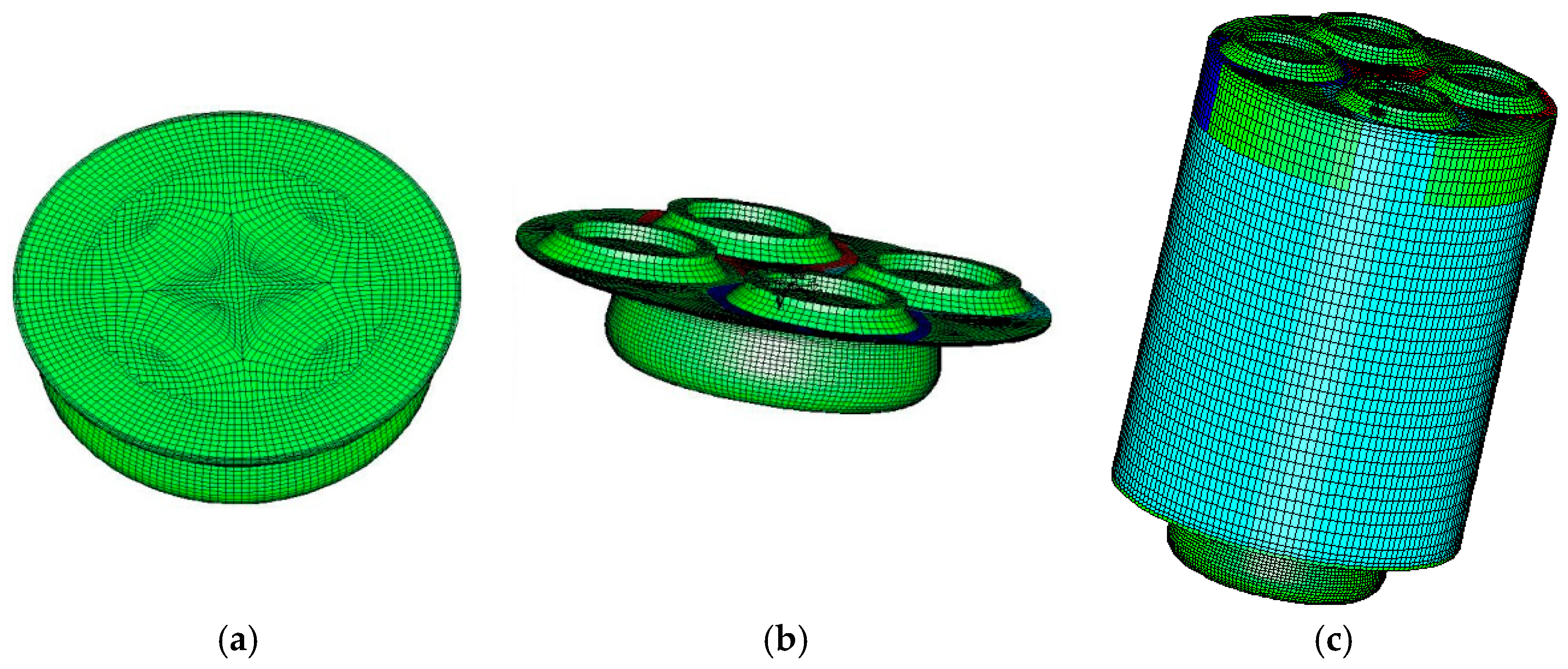
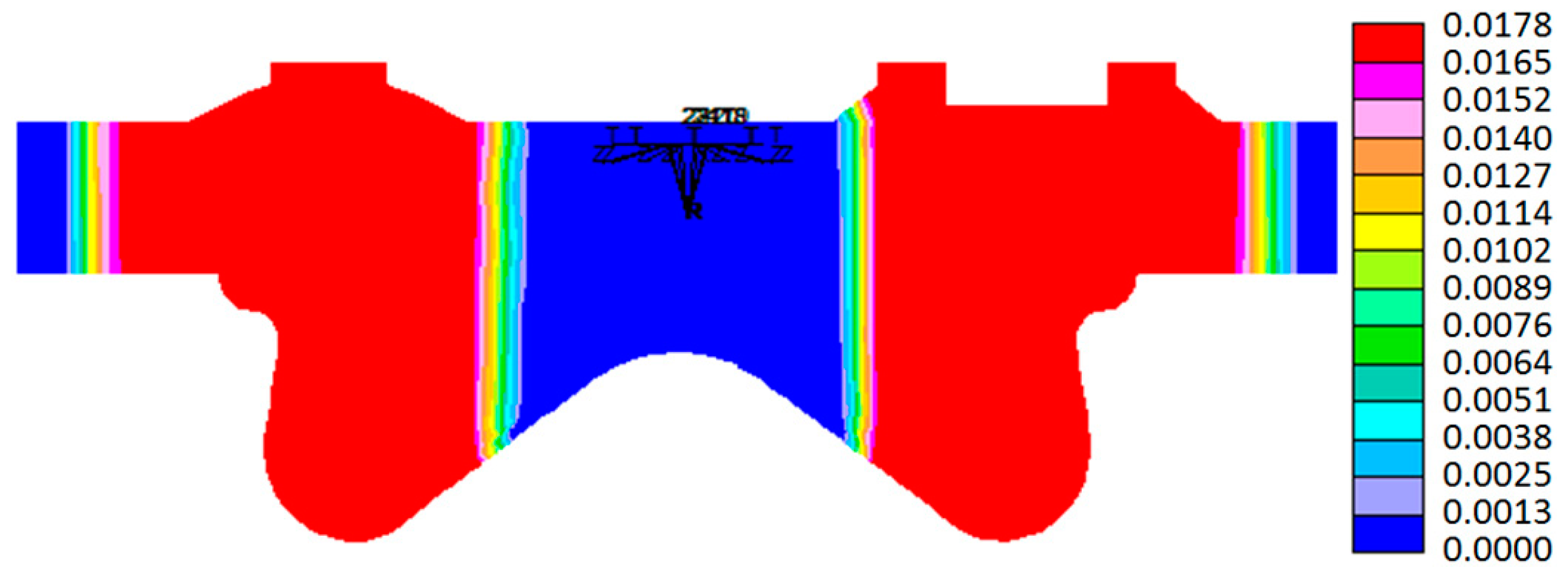
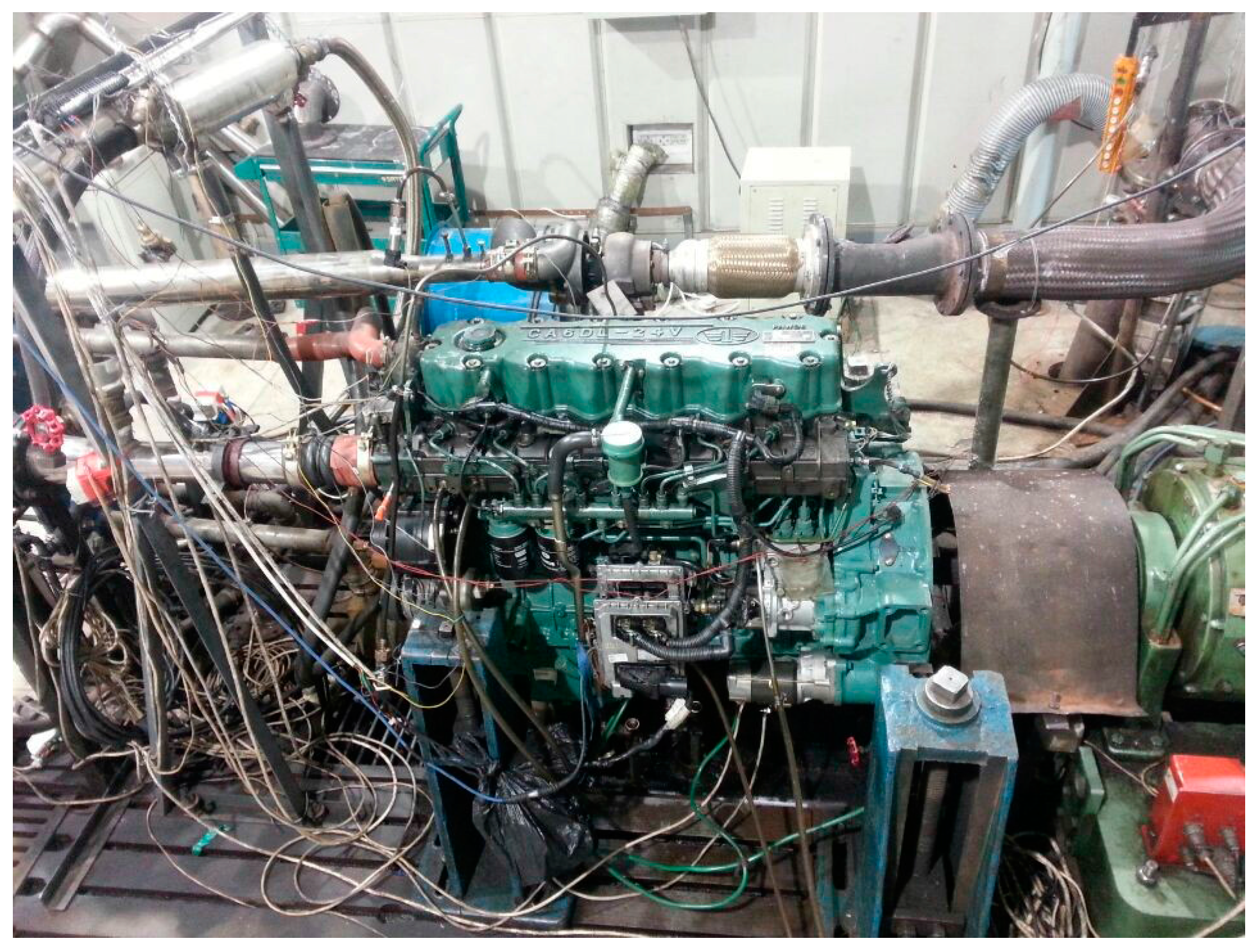
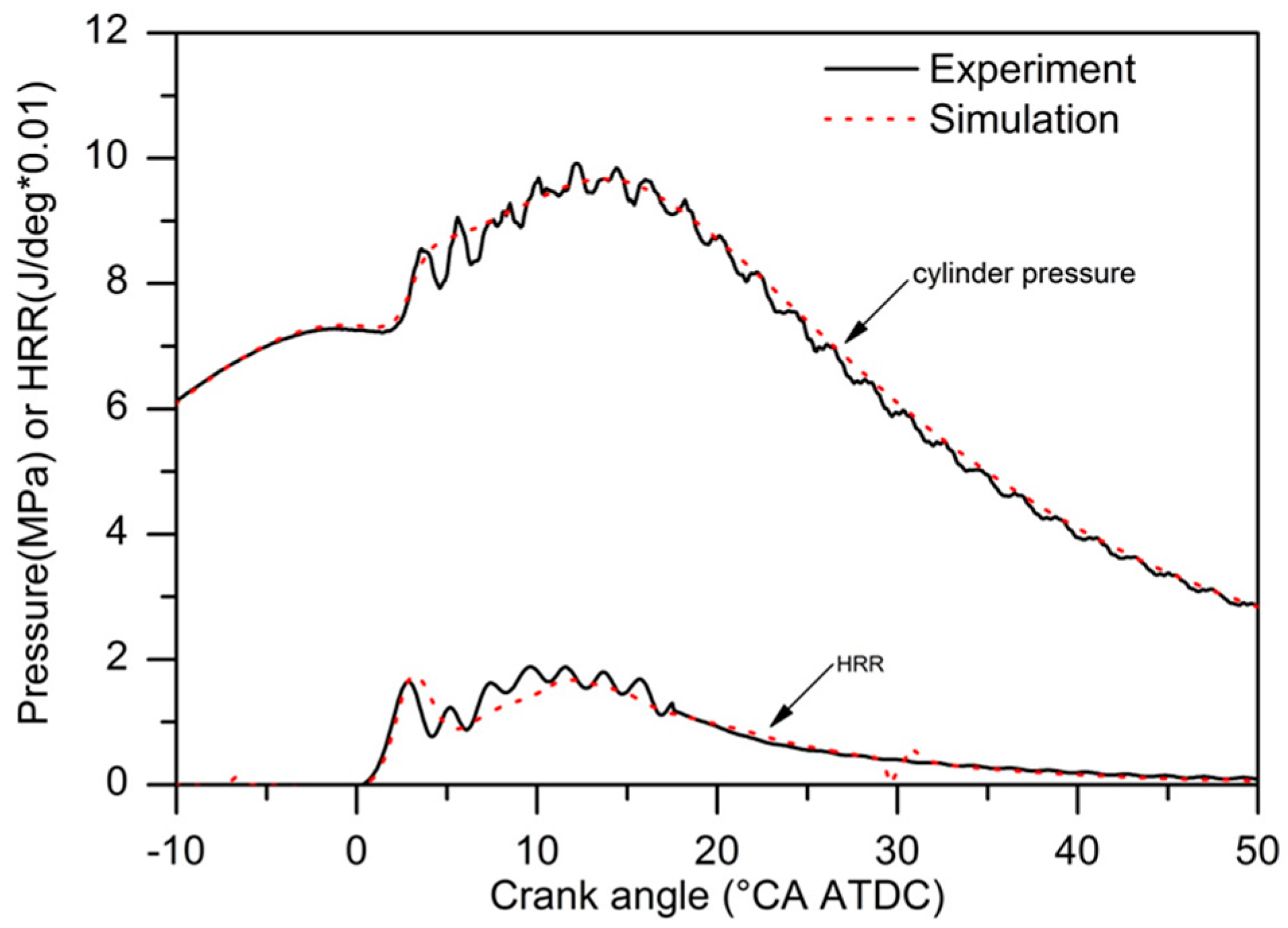
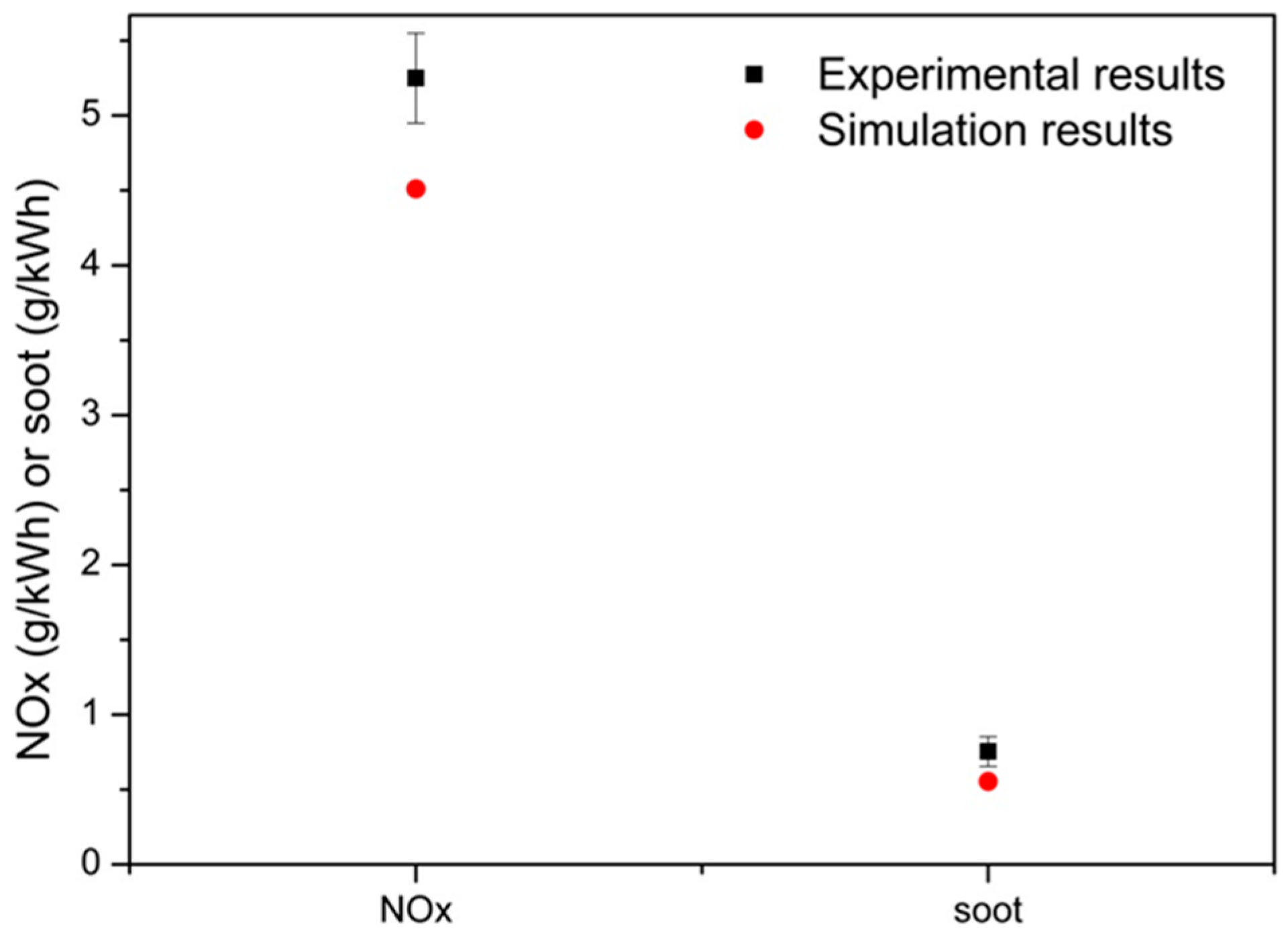
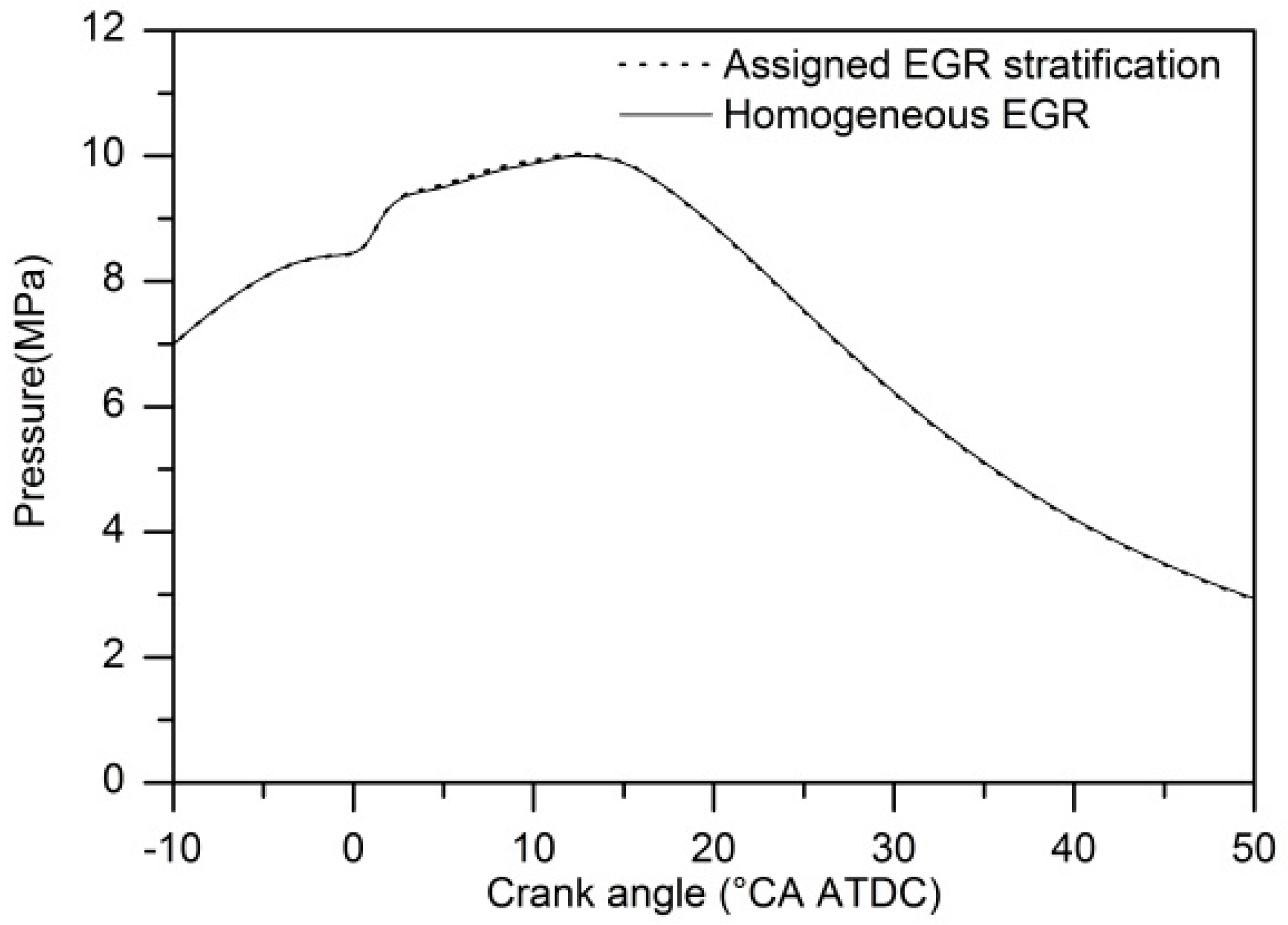
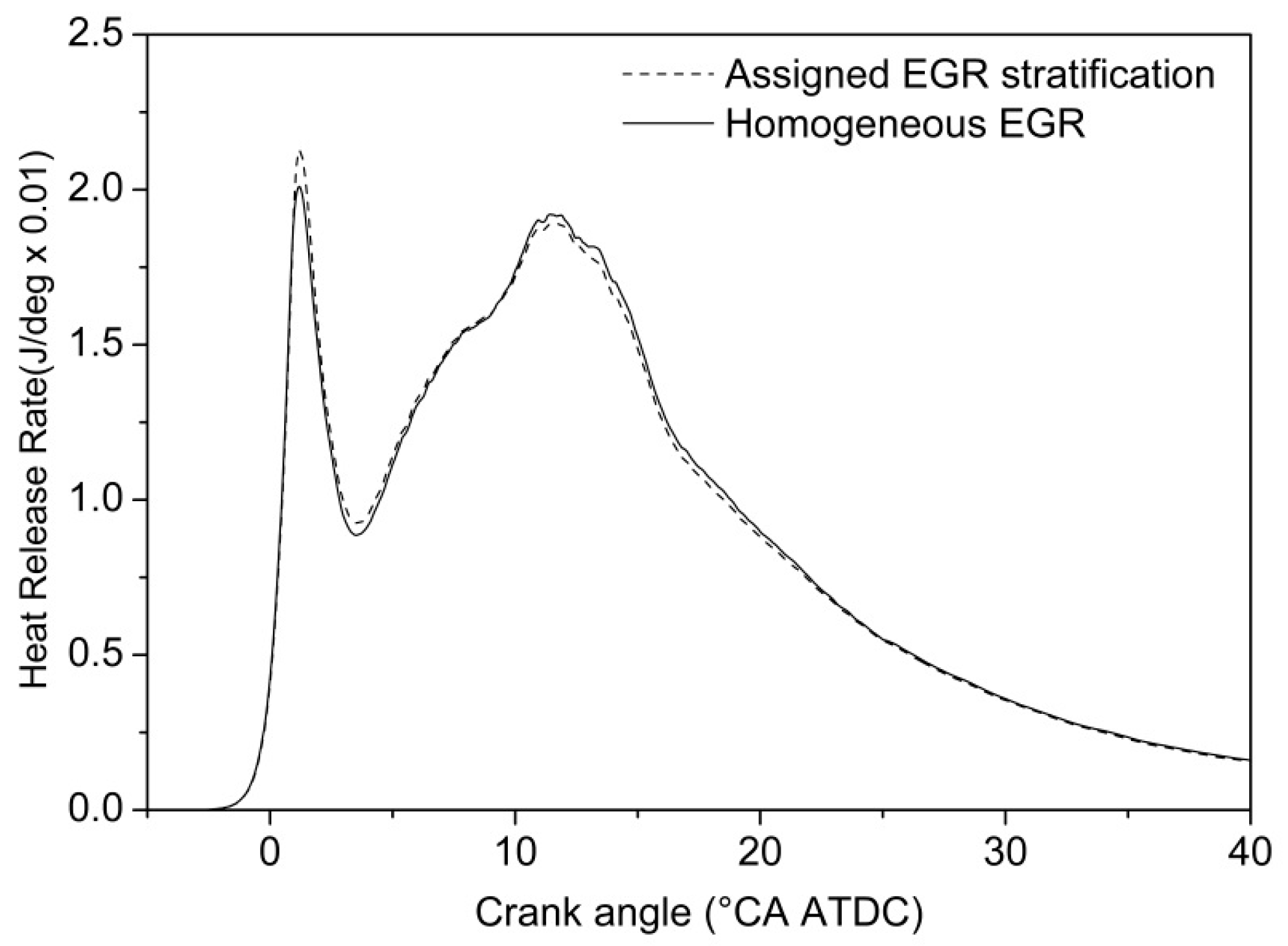
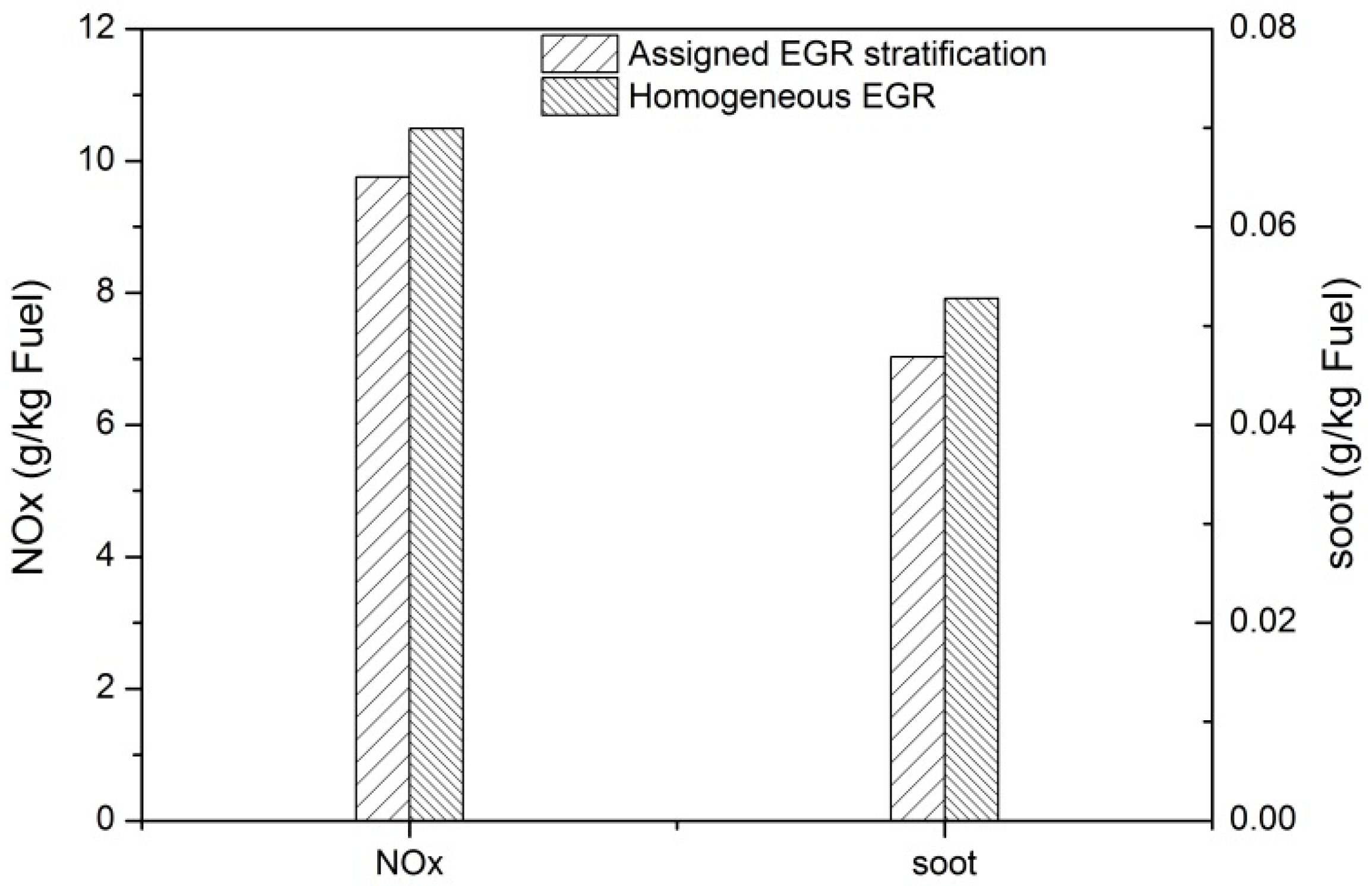
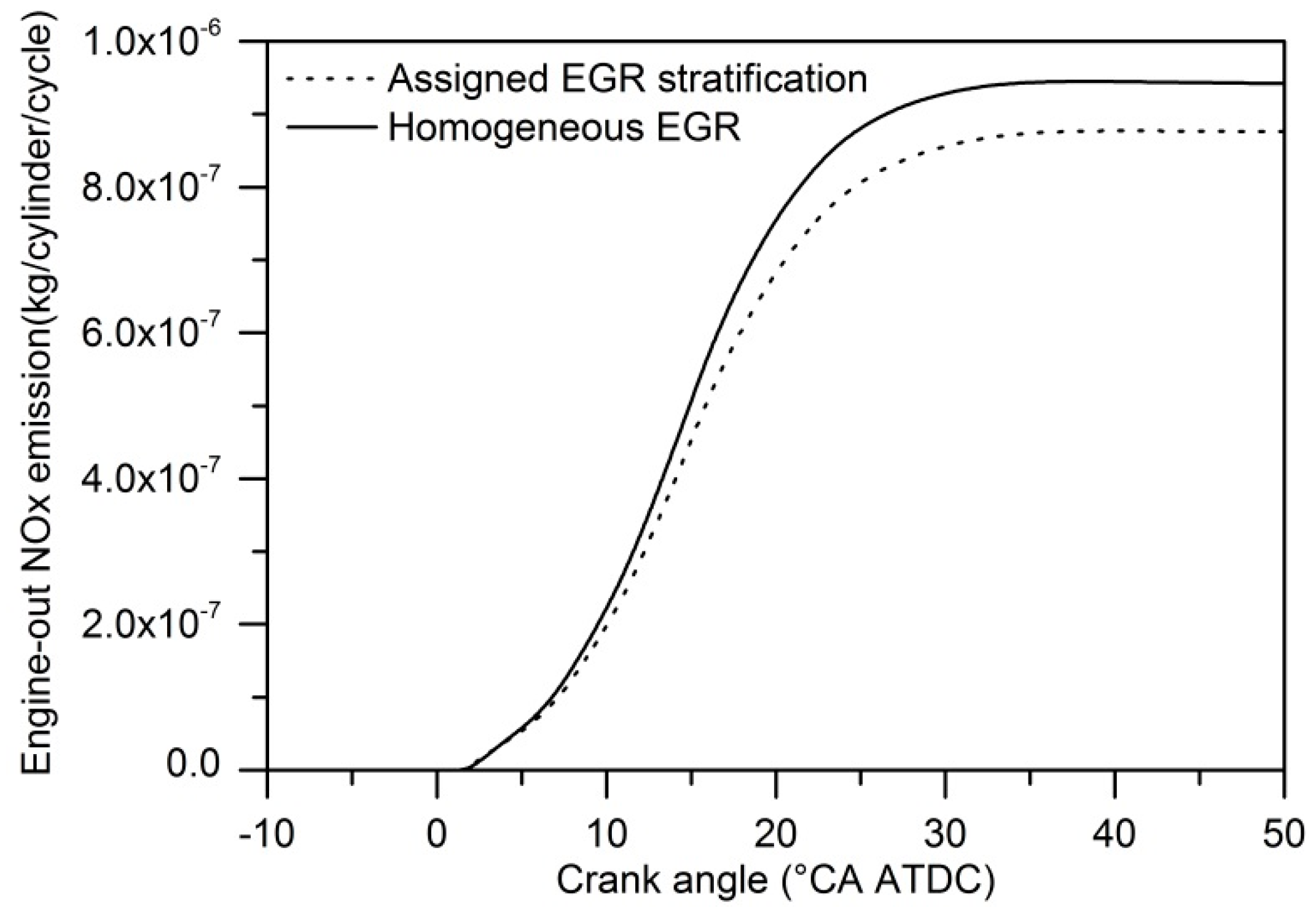
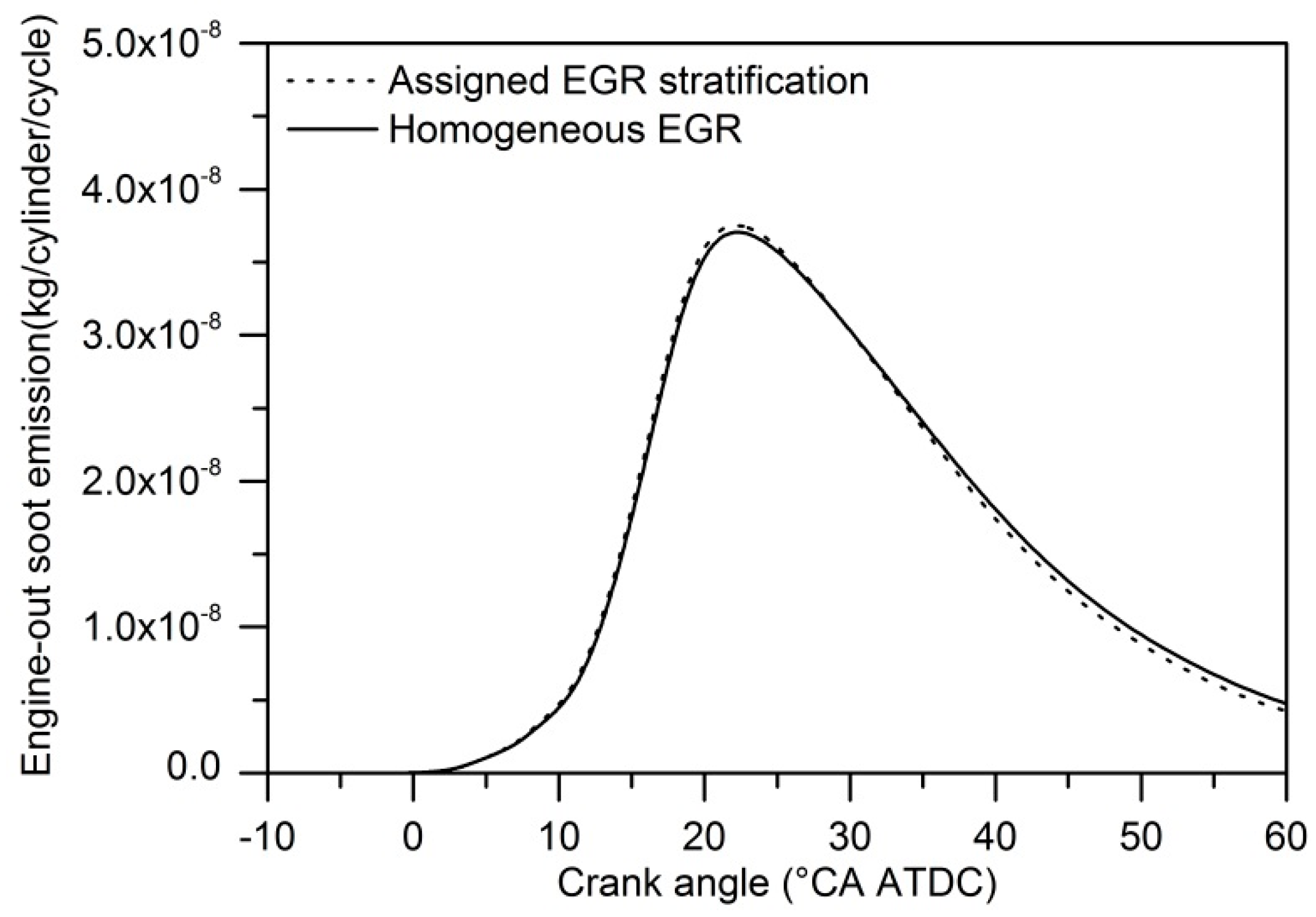
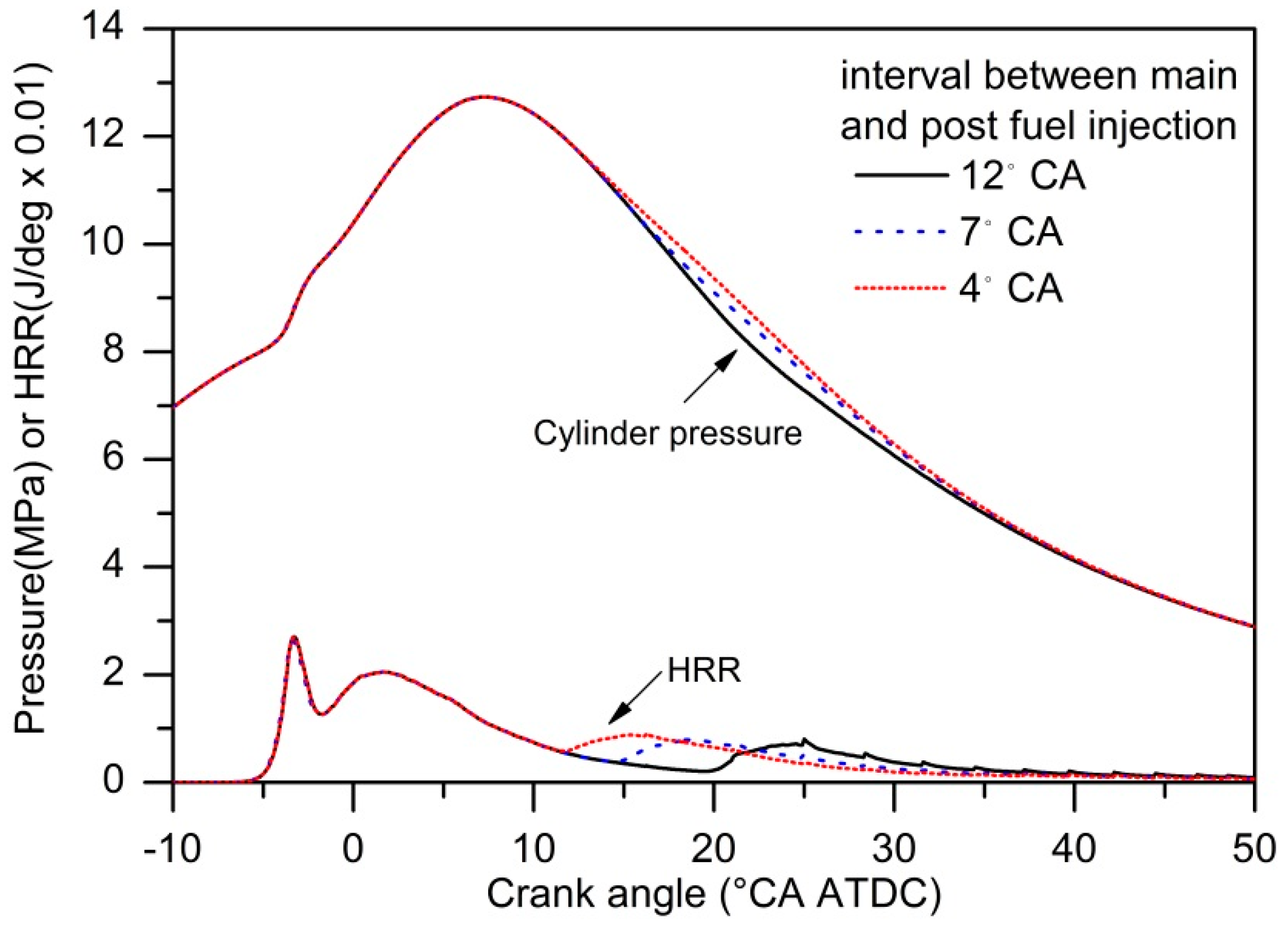
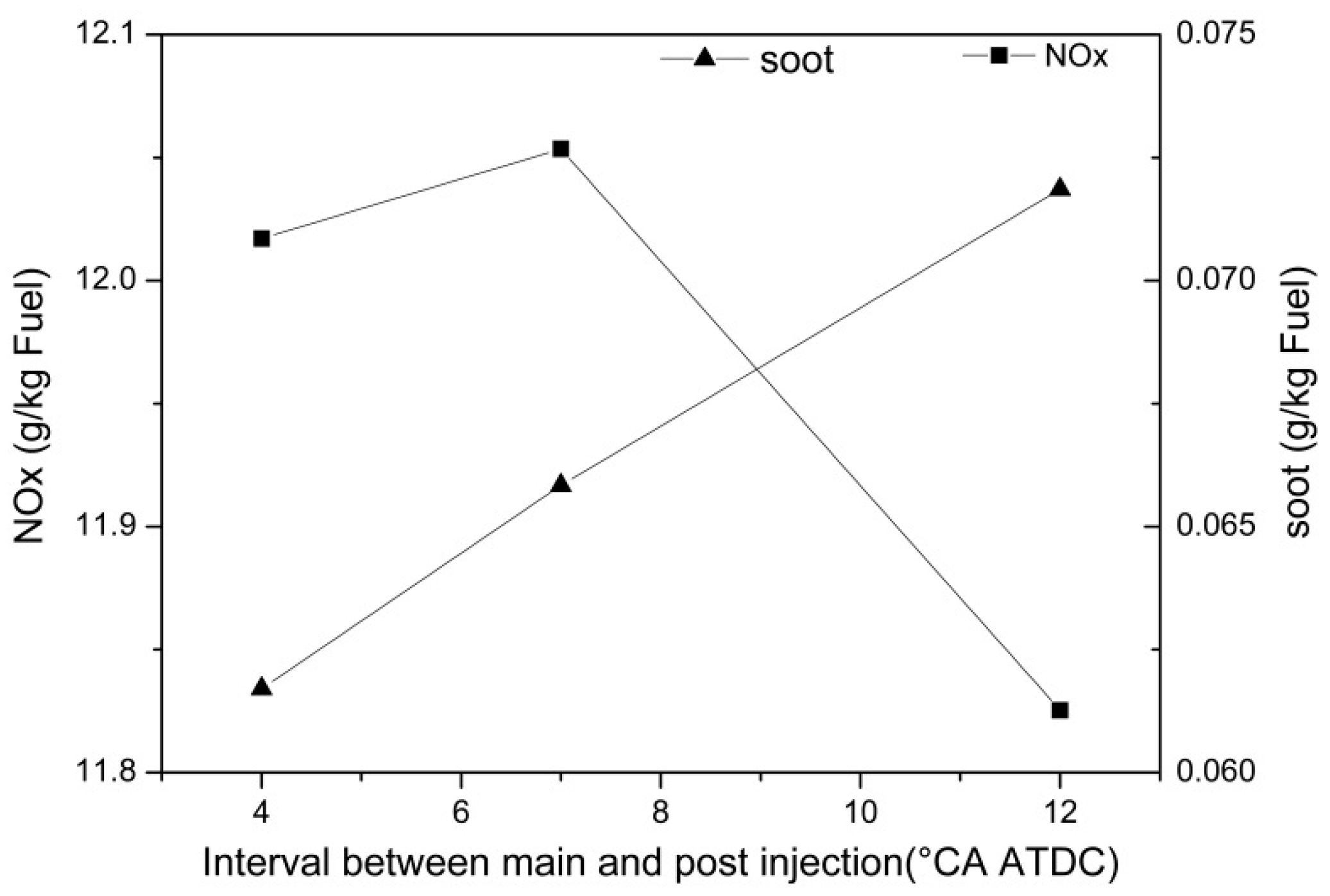
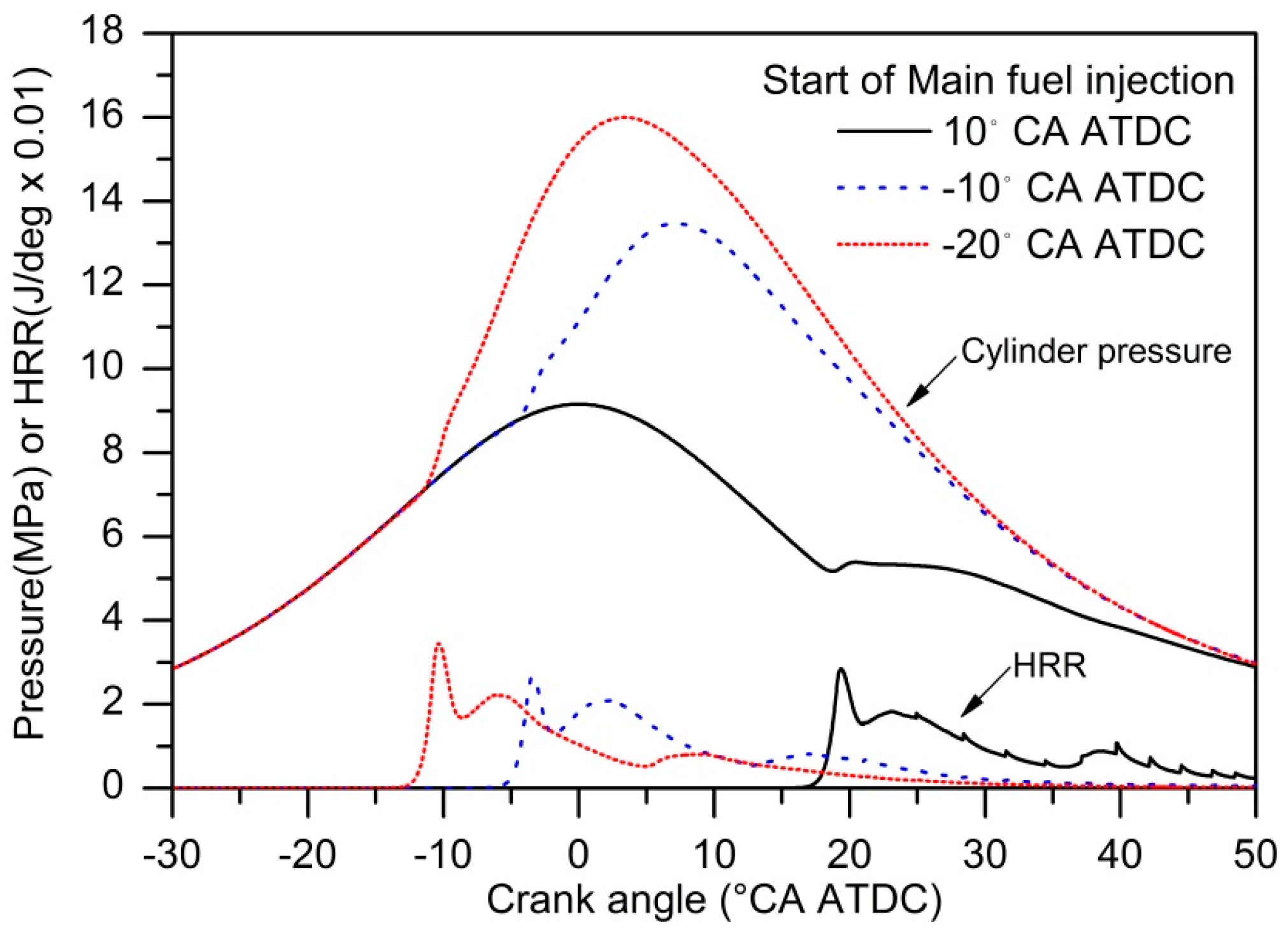
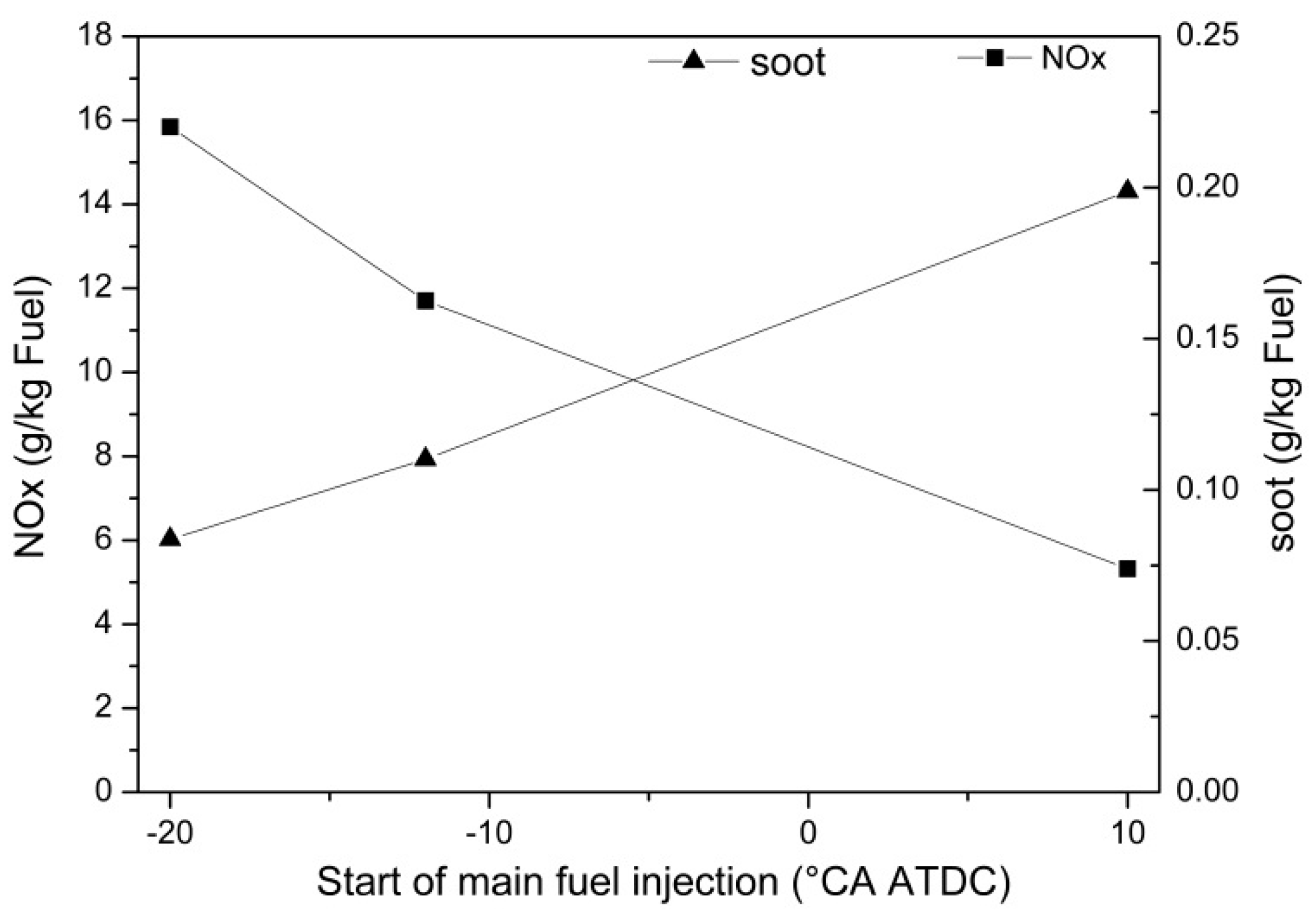
| Cases | Conditions | SOI 1 | Interval 2 |
|---|---|---|---|
| °CA ATDC | °CA | ||
| 1 | 1650 r/min 3 | −8 | Single 4 |
| 2 | 1650 r/min, assigned EGR stratification in cylinder with local EGR rate is 30% | −8 | Single 4 |
| 3 | −20 | 5.5 | |
| 4 | −10 | 5.5 | |
| 5 | 10 | 5.5 | |
| 6 | −12 | 4 | |
| 7 | −12 | 7 | |
| 8 | −12 | 12 |
| Engine Type | In-Line 6 Cylinder DI Diesel Engine |
|---|---|
| valves | 4 |
| Piston bowl | ω |
| supercharge | Turbocharging |
| EGR cooling | Intercooling |
| Bore × Stroke (mm × mm) | 112 × 145 |
| Displacement (L) | 8.6 |
| Compression Ratio | 17.0:1 |
| Rated Power/Speed (kW/rpm) | 257/2100 |
| Intake air temperature (K) | 313 |
| EGR rate | 10.6 |
| Fuel injection pressure (MPa) | 120 |
| SOI (°CA ATDC) | −8 |
| Injection type | Single injection |
| Fuel consumption (kg/h) | 24.23 |
| Intake mass flow rate (kg/h) | 649.47 |
© 2018 by the authors. Licensee MDPI, Basel, Switzerland. This article is an open access article distributed under the terms and conditions of the Creative Commons Attribution (CC BY) license (http://creativecommons.org/licenses/by/4.0/).
Share and Cite
Shen, Z.; Cui, W.; Ju, X.; Liu, Z.; Wu, S.; Yang, J. Numerical Investigation on Effects of Assigned EGR Stratification on a Heavy Duty Diesel Engine with Two-Stage Fuel Injection. Energies 2018, 11, 515. https://doi.org/10.3390/en11030515
Shen Z, Cui W, Ju X, Liu Z, Wu S, Yang J. Numerical Investigation on Effects of Assigned EGR Stratification on a Heavy Duty Diesel Engine with Two-Stage Fuel Injection. Energies. 2018; 11(3):515. https://doi.org/10.3390/en11030515
Chicago/Turabian StyleShen, Zhaojie, Wenzheng Cui, Xiaodong Ju, Zhongchang Liu, Shaohua Wu, and Jianguo Yang. 2018. "Numerical Investigation on Effects of Assigned EGR Stratification on a Heavy Duty Diesel Engine with Two-Stage Fuel Injection" Energies 11, no. 3: 515. https://doi.org/10.3390/en11030515
APA StyleShen, Z., Cui, W., Ju, X., Liu, Z., Wu, S., & Yang, J. (2018). Numerical Investigation on Effects of Assigned EGR Stratification on a Heavy Duty Diesel Engine with Two-Stage Fuel Injection. Energies, 11(3), 515. https://doi.org/10.3390/en11030515





